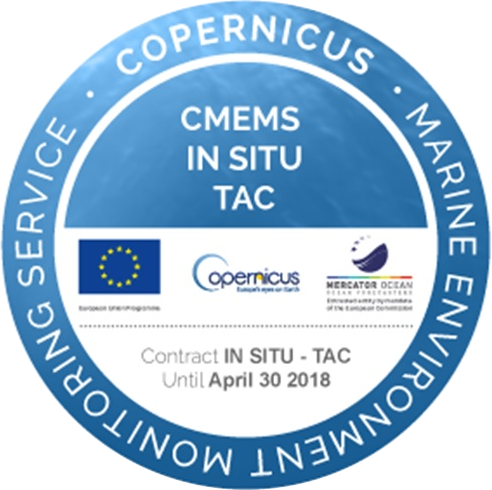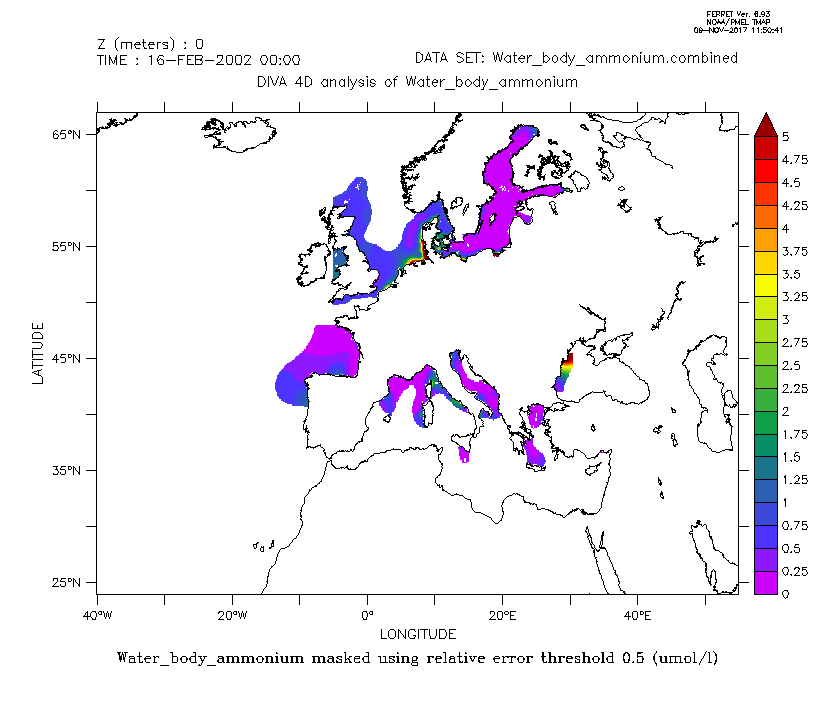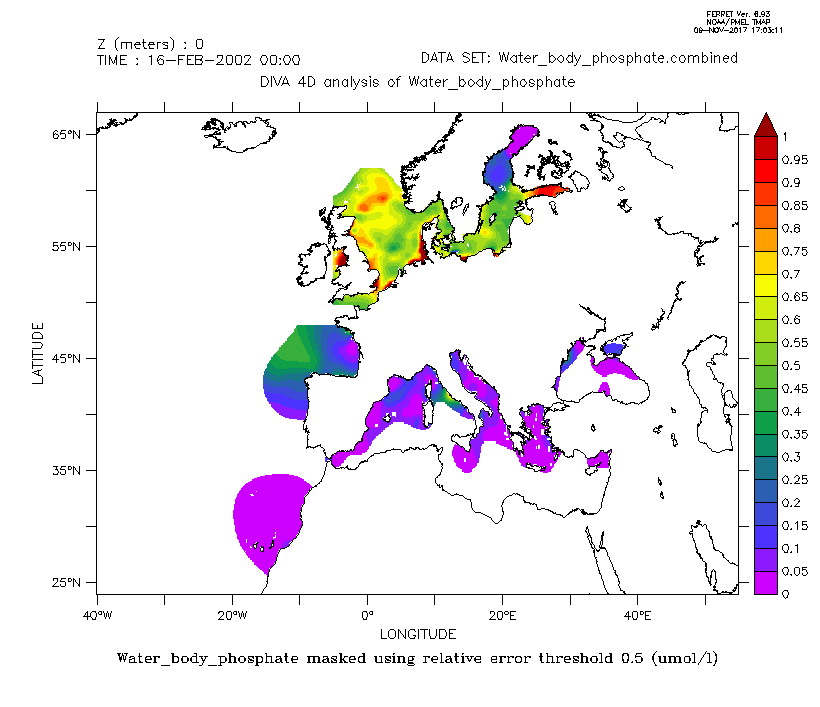2017
Type of resources
Available actions
Topics
Keywords
Contact for the resource
Provided by
Years
Formats
Representation types
Update frequencies
status
Service types
Scale
Resolution
-

The in-situ TAC integrates and quality control in a homogeneous manner in situ data from outside Copernicus Marine Environment Monitoring Service (CMEMS) data providers to fit the needs of internal and external users. It provides access to integrated datasets of core parameters for initialization, forcing, assimilation and validation of ocean numerical models which are used for forecasting, analysis and re-analysis of ocean physical and biogeochemical conditions. The in-situ TAC comprises a global in-situ centre and 6 regional in-situ centres (one for each EuroGOOS ROOSs). The focus of the CMEMS in-situ TAC is on parameters that are presently necessary for Copernicus Monitoring and Forecasting Centres namely temperature, salinity, sea level, current, waves, chlorophyll / fluorescence, oxygen and nutrients. The initial focus has been on observations from autonomous observatories at sea (e.g. floats, buoys, gliders, ferrybox, drifters, and ships of opportunity). The second objective was to integrate products over the past 25 to 50 years for re-analysis purposes... Gathering data from outsider organisations requires strong mutual agreements. Integrating data into ONE data base requires strong format standard definition and quality control procedures. The complexity of handling in situ observation depends not only on the wide range of sensors that have been used to acquire them but, in addition to that, the different operational behaviour of the platforms (i.e vessels allow on board human supervision, while the supervision of others should be put off until recovering or message/ping reception)°
-
Temporal series (annual mean values) and Long term Average (LTA) of water discharge for each river mouth where in situ data is available. Different sources can be mixed if any.
-

Frise chronologique des millésimes de modes d'occupation des sols produits par les régions françaises et par le programme Corine Land Cover.
-

Combined product of Water body ammonium based on DIVA 4D 10-year analysis on five regions : Northeast Atlantic Ocean, North Sea, Baltic Sea, Black Sea, Mediterranean Sea. The boundaries and overlapping zones between these five regions were filtered to avoid any unrealistic spatial discontinuities. This combined Water body ammonium product is masked using the relative error threshold 0.5. Units: umol/l.
-

Combined product of Water body phosphate based on DIVA 4D 10-year analysis on five regions : Northeast Atlantic Ocean, North Sea, Baltic Sea, Black Sea, Mediterranean Sea. The boundaries and overlapping zones between these five regions were filtered to avoid any unrealistic spatial discontinuities. This combined water body phosphate product is masked using the relative error threshold 0.5. Units: umol/l
-
Temporal series (annual mean values) and Long term Average (LTA) of water discharge for each river mouth where in situ data is available. Different sources can be mixed if any.
-
Dans un contexte marqué par de fortes mutations de l’environnement économique et social, le ROME (Répertoire Opérationnel des Métiers et des Emplois) est un outil au service de la mobilité professionnelle et du rapprochement entre offres et candidats. En décembre 2016, les référentiels de compétences du ROME évoluent afin d'améliorer la transversalité lors du rapprochement entre l'offre et la demande. Cette évolution consiste à : • réorganiser les compétences en savoir-faire et savoirs • reformuler les libellés en les simplifiant et les décontextualisant. --- Etat de la disponibilité de la donnée : - Data.gouv : donnée téléchargeable au format excel et mise à jour trimestrielle.
-
The European Ocean Biogeographic Information System - EurOBIS - is an online marine biogeographic database compiling data on all living marine creatures. The principle aims of EurOBIS are to centralize the largely scattered biogeographic data on marine species collected by European institutions and to make these data freely available and easily accessible. All data go through a number of quality control procedures before they are made available online, assuring a minimum level of quality necessary to put the data to good use. The available data are either collected within European marine waters or by European researchers and institutes outside Europe. The database focuses on taxonomy and distribution records in space and time; all data can be searched and visualised through a set of online mapping tools. All data are freely available online and easily accessible, without requiring a login or password.
-

La Base Adresse Nationale est une base de données qui a pour but de référencer l'intégralité des adresses du territoire français. Elle contient la position géographique de plus de 25 millions d'adresses. Elle est constituée par la collaboration entre : des acteurs nationaux tels que l'IGN, La Poste et La Poste ; des acteurs locaux tels que les collectivités, les communes, les SDIS ; des citoyens par exemple à travers le projet OpenStreetMap et l'association OpenStreetMap France. Le projet est co-gouverné par l'Administrateur Général des Données et le Conseil National de l'Information Géographique. --- Etat de disponibilité de la donnée : Data.gouv : donnée téléchargeable en csv et mise à jour hebdomadaire. OpenStreetMap : donnée téléchargeable en csv, shape et json et mise à jour hebdomadaire. PIGMA : lien qui renvoie à la BD Adresse (Octobre 2016). Mise à jour irrégulière.
-
Le Répertoire National des Associations (RNA) contient l’ensemble des associations relevant de la loi 1901, à savoir toutes les associations de France, dont le siège est déclaré en métropole ou dans les départements d’outre-mer, sauf dans les départements de la Moselle, du Bas-Rhin et du Haut-Rhin, qui relèvent du régime du Concordat. Le RNA contient également les associations reconnues d’utilité publique (dites "ARUP"). Les associations relevant de la loi 1901 sont déclarées en préfecture ou en sous-préfecture (au greffe des associations) : la création et les changements de statuts, tels que la modification du nom, du siège, des dirigeants, etc. doivent être déclarés et sont mis à jour dans la base du RNA. La mise à jour est effective une fois les données validées par le greffe ou suite à la publication au Journal officiel des associations et des fondations d’entreprise (JOAFE) d’une création, d’une dissolution (obligatoire) ou d’un changement de situation (publication au JOAFE non obligatoires). --- Etat de disponibilité de la donnée : - Data.gouv : donnée téléchargeable au format csv et mise à jour mensuelle.
 Catalogue PIGMA
Catalogue PIGMA